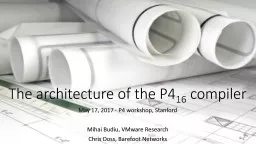

16 compiler May 17 2017 P4 workshop Stanford Mihai Budiu VMware Research Chris Doss Barefoot Networks P4 16 N ewest version of the P4 language finalized yesterday https ID: 612291
Download Presentation The PPT/PDF document "The architecture of the P4" is the property of its rightful owner. Permission is granted to download and print the materials on this web site for personal, non-commercial use only, and to display it on your personal computer provided you do not modify the materials and that you retain all copyright notices contained in the materials. By downloading content from our website, you accept the terms of this agreement.
Slide1
The architecture of the P4
16 compiler
May
17
, 2017 - P4 workshop, Stanford
Mihai
Budiu, VMware Research
Chris Doss, Barefoot NetworksSlide2
P416
Newest version of the P4 language (finalized yesterday!)https://github.com/p4lang/p4-spec/tree/master/p4-16/spec
This talk is about the (reference implementation)
compiler for
P416Compiles both P414 (i.e., P4 v1.0 and P4 v1.1) and P416 programsApache 2 license, open-source, reference implementationhttp://github.com/p4lang/p4cSlide3
Compiler goals
Support current and future versions of P4Support multiple back-endsGenerate code for ASICs, NICs, FPGAs, software switches and other targetsProvide support for other tools (debuggers, IDEs, control-plane, etc.)Open-source front-end
Extensible architecture (easy to add new passes and optimizations)
Use modern compiler techniques
(immutable IR*, visitor patterns, strong type checking, etc.)Comprehensive testing*IR = Intermediate RepresentationSlide4
Compiler data flow
P416parser
P4
14
parser
convertP4
14
P4
16
v1
IR
IR
frontend
IR
ebpf
back-end
your
own
backend
target-
specific
code
C code
BMv2
back-end
JSON
mid-
end
mid-
end
mid-
endSlide5
Compiler structure
Mid-end
Front-end
Back-end
P4
IR
IR
Target-specific
~25 distinct passes
Target-independent
~25 distinct passes
Same
IR
IR with target-specific
extensionsSlide6
Structure
Mid-end
Front-end
Back-end
P4
IR
IR
libFrontEnd.a
main()
Fixed
Simplify IR eliminating
constructs gradually
Library of pre-built passes
Mix and match
CustomSlide7
Implementation details
Common infrastructure for all compiler passesSame IR and visitor base classesCommon utilities (error reporting, collections, strings, etc.)C++11, using garbage-collection (-lgc)Clean separation between front-end, mid-end and back-end
New
mid+back-ends
can be added easilyIR can be extended (front-end and back-end may have different IRs)IR can be serialized to/from JSONPasses can be added easilySlide8
Intermediate Representation (IR)
ImmutableCan share IR objects safelyEven in a multi-threaded environmentYou cannot corrupt someone else’s stateStrongly-typed (hard to build incorrect programs)DAG
structure, no
parent pointers
Manipulated by visitorsIR class hierarchy is extensibleSlide9
IR
P4Front-end and mid-end maintain invariant that IR
is always serializable to a P4 program
Simplifies debugging and testing
Easy to read the IR: just generate and read P4Easy to compare generated IR with reference (testing)Compiler can self-validate (re-compile generated code)Dumped P4 can contain IR representation as commentsIR always maintains source-level positioncan emit nice error message anywhereSlide10
Visitor pattern
https://en.wikipedia.org/wiki/Visitor_pattern“In object-oriented programming and software engineering, the visitor design pattern is a way of separating an algorithm from an object structure on which it operates. A practical result of this separation is the ability to add new operations to existing object structures without modifying those structures.”
“Structure” = IR
“Algorithms” = program manipulationsSlide11
IR rewriting using visitors
Input DAG
Modified DAG
Dead code
New DAG
Output DAG
visitorSlide12
IR definition language compiled to C++
interface
IDeclaration
{ … }
abstract Expression { … }abstract
Statement : StatOrDecl
{}
class
AssignmentStatement
: Statement
{
Expression left
;
Expression right
;
print
{ out << left << " = " << right;
}
}
IR fields
Class hierarchySlide13
Learning the IR by example
Front-end and mid-end passes can all dump IR back as P4 sourcewith IR as comments/*
<P4Program>(18274)
<IndexedVector<Node>>(18275)
*//*
<Type_Struct>(15)struct Version
*/
struct
Version
{
/*
<StructField>(
10)major/0
<Annotations>(2
)
<Type_Bits>(9)bit<8>
*/
bit<8> major
;...Slide14
v1model.p4: A P414 switch model
Parse
verify
cksum
ingress
egress
compute
cksum
deparse
A P4
16
switch architecture that models the fixed switch architecture from the P4
14
spec
Provides backward compatibility for P4
14
programsSlide15
Testing the compiler
Dump program at various points and compare with referenceCompare expected compiler error messages (on incorrect programs)
Recompile
P4 generated
by compilerRun v1model.p4 programs using BMv2 on packet traces and compare to expected outputP4
P4
P4
P4
P4
P4
P4
=
=
=
Expected output
=
stderr
errors
p4c
p4c
P4
P4
p4c
p4c
P4
json
BMv2 simulator
p
acket trace
p
acket trace
=
e
xpected
packet traceSlide16
Lessons
P416 is a simple language,… but the P4 environment is complicatedSupports arbitrary architecturesArbitrary functionality in the architectureArbitrary extensions (
extern
blocks)
P416 is designed for extensibilityCompilers must support extensibility while preserving stabilityModularity/extensibility seems to workAt least 5 existing back-ends, for software, simulators, FPGAs, ASICsSpecification ImplementationGreat community: thank you all!